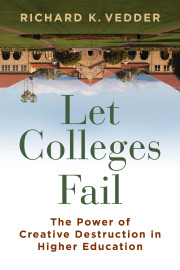The Supreme Court’s recent Chevron ruling, while rightly focusing on central issues like presidential immunity, also brought a potential boon for American higher education. This decision, which I believe holds promise for the future, has yet to be fully grasped by the higher education establishment.
Specifically, in Loper Bright Enterprises v. Raimondo, the Court invalidated the doctrine of Chevron deference prevailing since 1984. In the Chevron case, the Court dramatically curtailed the power of courts to rein in the actions of independent agencies and executive departments to overturn federal administrative diktats, which some think led to the creation of the modern administrative state.
The recent Supreme Court decision has had a profound effect on universities. As Jon Fansmith, the chief lobbyist for the American Council of Education, aptly pointed out, “Almost every aspect of running a modern campus is dictated in some way by federal regulations or guidance—whether that’s how you make staffing, compensation, training, or enrollment decisions, all the way down to the level of what you put on your website.”
I contend that the golden age of American higher education came in the generation before the rise in federal higher education activism, which began after obtaining statutory authority with the Higher Education Act of 1965 but most notably after the creation of the U.S. Department of Education in 1978.
America’s role in creating the world’s best universities dates back to before 1965, when both private dollars and state governments helped finance the planet’s best universities. Aside from obtaining resources, these schools benefited from competition and academic diversity—different kinds of schools, some progressive, some conservative, some religious, others militantly agnostic. We did not have stultifying schools teaching a uniform curriculum with little diversity, the model in much of the rest of the world.
But as Fansmith says, the Feds took that away, especially strongly beginning with the Obama Administration in 2009.
The modern federal administrative state has robbed most universities of much of their individuality, with a few schools of the Hillsdale or Grove City College variety that have completely severed ties with the Feds escaping that fate, generally with great success. The modern-day Department of Education’s sins include the lamentable declaration of war against college men and Anglo-Saxon rules of judicial conduct with the 2011 “Dear Colleague” letter that led most colleges into adopting an almost “guilty until proven innocent” attitude regarding allegations of male student sexual misconduct. The jihad towards men has contributed to a significant decline in male enrollment.
A second significant sin came with the Obama era: “gainful employment rules” applied against for-profit colleges, not against mediocre or worse public colleges, and were designed to annihilate a small but often vibrant sector.
But the biggest problem relates to the terrible federal student loan program. In its best days, the program was a disaster, as it is the primary culprit in the tuition fee explosion of modern times. But with the Biden loan forgiveness programs, it has taken on unjust and costly dimensions of truly Titanic proportions. Aside from its policy inappropriateness, the contempt for the rule of law shown by Education Secretary Miguel Cardona in the light of adverse court rulings has been shocking.
The Loper Bright Enterprises v. Raimondo decision may have great, long-term positive effects on higher education by giving the courts greater ability to block outrageous administrative fatwas that contradict American legal traditions. Yet that outcome is far from assured. Judicial adherence to stare decisis—deferring to Supreme Court decisions—is somewhat spotty.
Interestingly, when the Chevron case was decided in 1984, conservatives were mostly happy since it was seen as curtailing the power of liberal judges. Yet today’s conservatives also love its reversal because it reduces the power of agencies adhering to a predominantly liberal administrative agenda. The political orientation of both judges and powerful bureaucratic apparatchiks changes with time.
To be sure, the fate of America’s universities depends on many things, and not all their ails are federally inflicted. To cite just one example, the rise in debilitating grade inflation roughly coincides with the growth in federal involvement, and while there may be links between those two things, they are not obvious or strong. Still, my tentative assessment is that the Supreme Court’s recent action improved the environment where higher learning occurs in America.













